
The blue-backed manakin is a small passerine bird which breeds in tropical South America, its range extending from Colombia and Tobago to southeastern Brazil. It is found in deciduous forests but not evergreen rainforests. It is a small, plump bird about 13 centimetres (5 in) long. Males have black plumage with a bright blue back and a red or yellow crown. Females and juveniles are olive-green with paler underparts. At breeding time, males are involved in a cooperative lekking behaviour during which they jump and twirl. This is a fairly common species with a wide range, and the International Union for Conservation of Nature has rated its conservation status as being of "least concern".
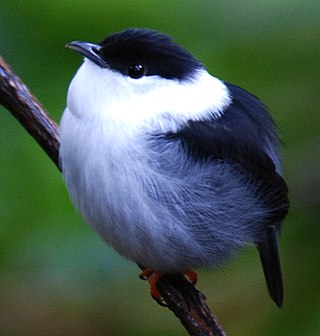
The white-bearded manakin is a small passerine bird which breeds in tropical South America. It can be found in Colombia, Venezuela and Trinidad south to Bolivia and northern Argentina. This manakin is found in forests, secondary growth and plantations. It is a small, plump bird about 10.7 centimetres (4.2 in) long. Males have a black crown, upper back, wings and tail and are otherwise white. Females are olive-green and resemble female golden-headed manakins. At breeding time, males are involved in lekking behaviour on the forest floor during which they puff out their neck feathers. This is a fairly common species with a wide range, and the International Union for Conservation of Nature has rated its conservation status as being of "least concern".

The Araripe manakin is a species of critically endangered bird from the family of manakins (Pipridae). It was discovered in 1996 and scientifically described in 1998. The species epithet commemorates Brazilian zoologist and wildlife filmmaker Werner Bokermann, who died in 1995. Because of its helmet-like crown it has received the Portuguese name soldadinho-do-araripe which means "little soldier of Araripe". This name also associates it with the related, but more widespread, helmeted manakin, which is known simply as the soldadinho.

The white-collared manakin is a passerine bird in the manakin family. It is a resident breeder in the tropical New World from southeastern Mexico to Costa Rica and the extreme west of Panama. It typically inhabits thickets at the edges of moist forest, tall secondary growth and old cacao plantations. It is a small, plump bird about 11 centimetres (4.3 in) long. Males have a black crown, mid-back band, wings and tail, an olive-green rump and yellow belly. Females and juveniles are olive-green with yellow bellies and resemble female orange-collared manakins. At breeding time, males are involved in lekking behaviour on the forest floor during which they puff out their neck feathers. This is a fairly common species with a wide range, and the International Union for Conservation of Nature has rated its conservation status as being of "least concern".

The white-crowned manakin is a small passerine bird in the manakin family Pipridae. This common and extremely widespread manakin is one of the most easily identified, even in female plumage. It is a resident breeder in the tropical New World from Costa Rica to northeastern Peru and eastern Brazil. It was traditionally placed in the genus Pipra, but is now placed in its own monotypic genus Pseudopipra. It is a small, compact bird about 10 cm (3.9 in) long. Males have black plumage with a white crown which can be erected as a crest, the only member of the Pipridae to possess both an all-black body and a gleaming white crown. Females and juveniles are olive-green, with a grey head and throat, and greyish-green or olive underparts. At breeding time, males are involved in a lekking behaviour. This is a fairly common species with a wide range, and the International Union for Conservation of Nature has rated its conservation status as being of "least concern".

The helmeted manakin is a species of small passerine bird in the manakin family Pipridae. Unlike most manakins, a family associated with tropical rainforests, the helmeted manakin inhabits the seasonally dry Cerrado savanna of Central Brazil.

The long-tailed manakin is a species of bird in the family Pipridae native to Central America where it inhabits both wet and dry tropical and subtropical forests. It is a small, plump bird about 10 centimetres (4 in) long. Males have black plumage with a blue back and a red crown, and the two central tail feathers are greatly elongated. Females and juveniles are olive-green with paler underparts. At breeding time, males are involved in a cooperative lekking behaviour with a complex coordinated courtship dance. This is a fairly common species with a wide range, and the International Union for Conservation of Nature has rated its conservation status as being of "least concern".

The yellow-crested manakin, also called the yellow-crowned manakin, is a species of bird in the family Pipridae, the manakins.

The pin-tailed manakin is a suboscine species of bird within the manakin family, Pipridae. This species is endemic to the Eastern coast of Brazil within the humid Atlantic Forest, and its range extends from the State of Bahia to the State of Rio Grande Do Sul. The pin-tailed manakin is monotypic within the genus Ilicura, and has no known subspecies. It is a relatively small species that has pronounced sexual dimorphism. Male birds of this species have a bright white neck, chest, auriculars, and flanks. They have black and dark-green wings, with a signature pin shape tail that has a small fork near the tip, helping to give it its common name in English. The males are most easily identified by their characteristically vibrant red fore-crown and rump. The females of this species are a muted green, except for their neck and auriculars—which are light grey, and their cream-colored chest. Both male and female birds of this species share a slightly elongated head shape that gives them a distinguished raised forehead. The pin-tailed manakin's vocalizations are quiet, but resemble a high-pitched “see-see-see” in descending tones.
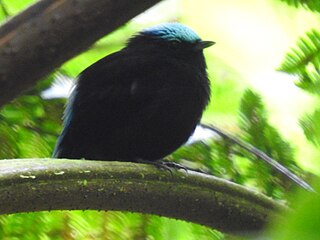
The cerulean-capped manakin is a species of bird in the family Pipridae. It is endemic to Peru.

Lepidothrix is a genus of passerine birds in the manakin family Pipridae. Birds in the genus are predominantly found in South America, but one species, the velvety manakin, also ranges into Central America. The females of this genus have green plumage with yellow bellies, as do some of the males. The remaining males have black plumage with white or blue crowns. Some also have yellow bellies or blue rumps.
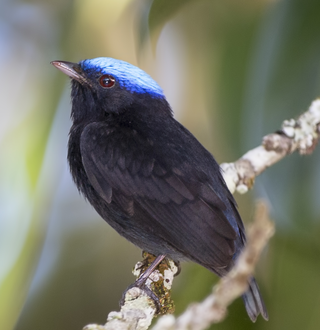
The blue-capped manakin is a species of bird in the family Pipridae. The males have a brilliant blue cap; some have black, others have green body plumage, but the relationship between the subspecies is not well understood.

The opal-crowned manakin is a species of bird in the family Pipridae. It is endemic to Brazil.

The blue-rumped manakin is a species of bird in the family Pipridae. It is found in Colombia, Ecuador, and Peru. Its natural habitat is montane forest and, in Ecuador, the species is considered a foothill specialty. These tiny manakins, which average 8 cm (3.1 in) in length, are infrequently encountered away from their leks, where the black, white-capped and blue backed males display for female attentions.
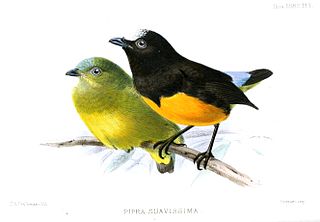
The orange-bellied manakin, also known as the tepui manakin, is a species of bird in the family Pipridae. It resembles and is closely related to the white-fronted manakin, and the two were formerly considered conspecific.

The golden-crowned manakin is a small species of perching bird in the manakin family (Pipridae). It is endemic to the south-central Amazon Rainforest in Brazil, and it is threatened by habitat loss.

The wire-tailed manakin is a species of bird in the family Pipridae. It forms a superspecies with both the Band-tailed Manakin and the Crimson-hooded Manakin . It is found upriver in the western Amazon Basin and the neighboring countries of northern Peru, eastern Ecuador and Colombia, and southern and western portions of Venezuela. In Venezuela it occurs upriver in the Orinoco River basin, but not the final 1300 km; its range in Venezuela continues around the Andes cordillera to the northwestern coast. In northwest Brazil, the species ranges from Roraima and Amazonas west to Venezuela and Colombia, and southwest from Rondônia and Acre to Peru and Ecuador.

Ceratopipra is a genus of passerine birds in the family Pipridae.

The striolated manakin or western striped manakin is a small South American species of passerine bird in the family Pipridae. It is found in west and north west Amazonia. The striolated manakin was formerly considered conspecific with the kinglet manakin with the common name "striped manakin". Males have a bright red crown, which the females lack.
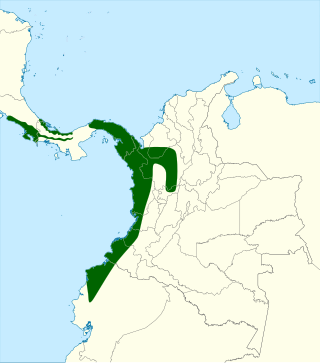
The velvety manakin is a species of bird in the family Pipridae. It is found from Costa Rica to Ecuador. Its natural habitat is subtropical or tropical moist lowland forest.























